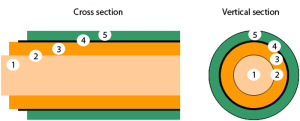![]() In many industries, especially in telecommunications, optical fibres replace the good old copper cables to transmit information. But what exactly are optical fibres? How do they work? And how are they designed? Here, we will answer frequently asked questions about the topic.
In many industries, especially in telecommunications, optical fibres replace the good old copper cables to transmit information. But what exactly are optical fibres? How do they work? And how are they designed? Here, we will answer frequently asked questions about the topic.
What are optical fibres?
Basically, optical fibres are nothing more but cables. But instead of power (electrons), light (photons) is conducted through the core to transmit information.
Optical communications is the generic term for processing and transmitting information in the form of light.
How are optical fibres designed?
The middle of an optical fibre consists of the core made of quartz glass or plastic fibres. The light is conducted mostly through the core.

Between core and cladding is a boundary layer, which reflects the rays of light. The refractive index defines how the rays are reflected.
The second layer is the cladding through which the rays are transmitted as well. However, the cladding has a lower refractive index than the core. The buffer covers the cladding and keeps humidity away from core and cladding.
Finally, the jacket protects the optical fibre from mechanical damages.
How do optical fibres transmit rays?
At first, elecric input signals are converted into rays using an electro-optical converter. Now, the rays flow through the optical fibres. After their journey through the fibre, they are received by an optoelectronic converter. Here they are converted into electronic signals. The core diameter varies depending on the type of optical fibre in use. Broader cores can transmit more rays.
Optical fibres can be laid around corners. However, you have to ensure that you don’t bend the cable too much. Otherwise the flow of rays might be disrupted.
What types of optical fibres are there?
There are different types of optical fibres.
Multi-mode fibres with step-index profile
Step-index multi-mode fibres are the simplest optical fibres. They consist of a glass core with a constant refractive index. Many rays can be conducted through this fibre. The rays are refelected with different intensities and take a zick-zack course through the core. However, the refractive index remains constant.

Since light rays are often and differently reflected, this type of fibre causes time delays. Therefore these cables are especially suited for transmitting low bandwidths (up to 100 MHz) and transmission lengths up to 1 km.
Typical core diameters for this type of fibre are 100, 120 or 400 µm..
Multi-mode fibres with graded index
Similar to step-index fibres, multi-mode fibres can also transmit multiple light rays at the same time. The most common refractive index profile for a graded-index fiber is nearly parabolic. The fibre has a great output pulse. Unfortunately, this type of cable is more complex to manufacture and therefore more expensive than step-index multi-mode fibres.

Typical core diameters of this type of fibre are 50 µm, 62,5 µm, 85 µm oder 100 µm at mantle diameters of 125 µm oder 140 µm.
Graded-index multimode fibres are the most common fibres used in data networks.
Single-mode fibres
Single-mode fibres have a very small core diameter through which only one light ray can be conducted. Due to this aspect, there are no time delays when using this type of fibre.

Single-mode fibres are very complex to manufacture and hence rather expensive. However, their features enable the transmission of high bandwidths over large distances (100 (Gbit/s)km).
What advantages does using optical fibres have?
Compared to common cables, optical fibres have the following advantages:
- No interfering radiation, because the signal is transmitted optically
- Optical transmission is almost tap-proof
- High bandwidths over long distances
- Resistant against electromagnetic interferences
- Can be used with other cables
(Image source: TonyHegewald_pixelio)
- Trade shows 2023: Experience G&D KVM products live and up close - 11. January 2023
- Innovative KVM solutions for control rooms - 14. December 2022
- Ada Lovelace – a true visionary and the world’s first female programmer - 12. December 2022

